“Spotty- the male Black-naped Monarch (Hypothymis azurea) made his stand as an able and active nest building contributor in an earlier article HERE. Together with his mate, the pair was discovered on 27th March 2009 in Krau Wildlife Reserve, Pahang Peninsula Malaysia – making it likely to be the first recorded sighting and documentation in photography of male active nest building participation.
“My revisit to Cat Tien National Park, S. Vietnam on 20th April 2012 saw another nesting site created near the accommodation quarters.
“In view there had not been many images contributed there after 2009, of male active participation in nest building, I have prepared an assemblage of images for readers’ enjoyment and further documentation of a breeding pair of Black-naped Monarch – particularly the male to include emphasis on nesting materials used.
“Let me introduce Ezekiel- the male Black-naped Monarch to our readers (above left). I took to a mid-morning coffee break and lay on a hammock to cool off under an attap shed roofing. 5meters above ground, I noticed something odd swaying and dangling from a shady large tree. The air was still and with no breeze (above right).
“A broken, withered tree branch that got lodged amongst some vines and left suspended in mid-air became a prospective place to build a nest on. A bird was found swaying with it (above left).
On closer examination, an auxiliary branch and a simple leaf set the framework for the nest (above right).
“It is interesting to note Black-naped Monarch seemed to have a penchant for specific colours and items – green, brown and white as well as to their choices of nesting materials in comparison to other nests images of same species.
“It reminds me of the Satin Bowerbirds (Ptilonorhynchus violaceus) of Australia who have a penchant for blue collectables of straws, sweet wrappers, seeds, plastic caps, straps etc… and had them arranged as avenue to their bowers (below left).
“A nest comparison of Black-naped Monarch to include material description of the ones I had observed is as follows – nest March 2009 (above right), nest April 2012 (below left).
“Specific species of green, fresh bryophytes/ moss are being used in the weave with Ezekiel- the male Black-naped Monarch bringing in a substantial sample (above right).
“Assorted brown foliage to include specifically broken bamboo sheaths added bulk to a pouch looking nest that would eventually finish off in the shape of a cup (below left). For strength and durability, fine roots were good choice nesting materials weaved in to hold and withstand duration of nesting period (below right).
“For white, I am particularly intrigued by this image of Ezekiel bringing in a soft, white spider egg sac to add contrast and texture to his creation. Initially thought to be white tissue paper of sorts or white petal blooms, it came to my attention upon doing some article research, these white looking soft materials are egg sacs of spiders. And perhaps waterproof too like soft turtle egg shells (below left)?
“There had to be plenty of specific species of spiders in that area to produce white egg sacs preferred by these ‘blue fairies’. It was interesting to note the hatchings of spiderlings coincided with nesting periods of Black-naped Monarch.
“Also, a symbiotic arrangement perhaps not to be discounted for the birds did the spiders a favour by discarding their unwanted post hatching egg sacs in exchange for some cobwebs as essential nest ingredients.
“Notice how the cobweb is delivered- held delicately by Ezekiel’s whiskers. Shown in this nest image includes white fluffs and cocoon silk (above right).
“Notice too Ezekiel spotting a black skull cap, skilfully cling wrapped the branch with the cobweb to secure the nest with his blue bill (below left).
“The nest was further adjusted and shaped by Ezekiel sitting in and shuffling about. This image – I am particularly impressed as it shows one of the adorned white egg sacs stretched out like an opened umbrella for that extra maestro’s touch that I am convinced of its origins (above right)!
“I wonder if monarch being insectivores, some of those spiders came as a lunch package deal with the cobwebs…
“Ezekiel with frontal black crescent necklace bids farewell to readers with these two suggestive images that say all.
“I am not just a good looking ‘Lam Chiow’ (blue bird) guy but also meets the approval of my Jewess partner, both in usefulness and productivity… (above)!
References made:
The Birds of the Thai-Malay Peninsular Vol:2 by David R. Wells
The Black-naped Monarch in Singapore 2009-Lok
Avian Writer Daisy O’Neill
Penang, Malaysia
COPYRIGHT ARTICLE AND ALL IMAGES COPY: COURTESY OF DAISY ONEILL BIRD CONSERVATION FUND


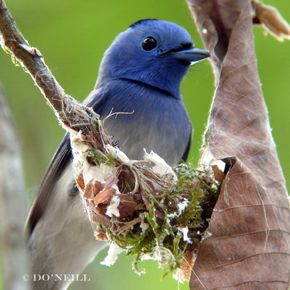
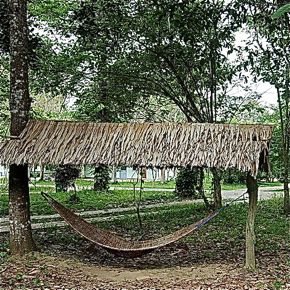


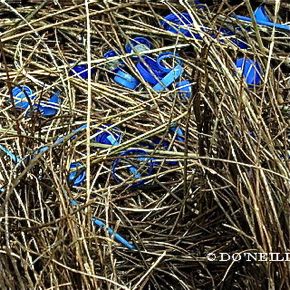
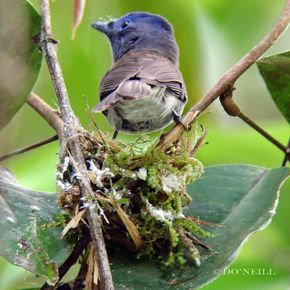

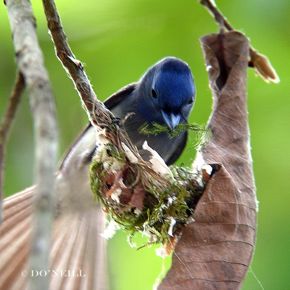


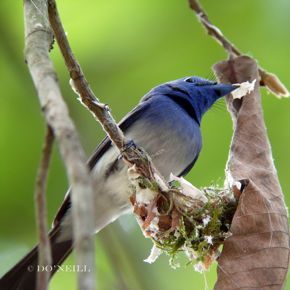
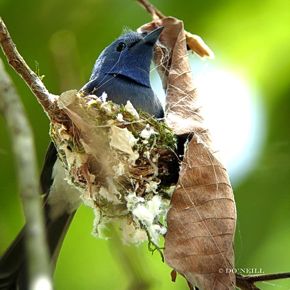
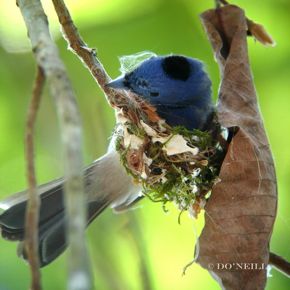
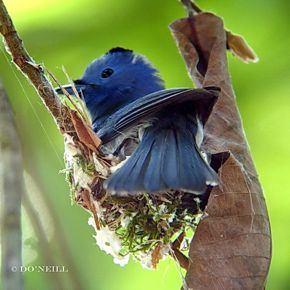

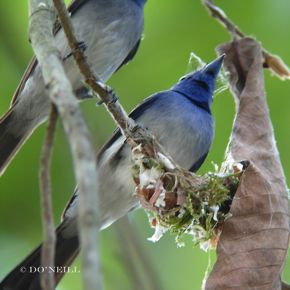







One Response
lovely photos
and that’s a beautiful bird!